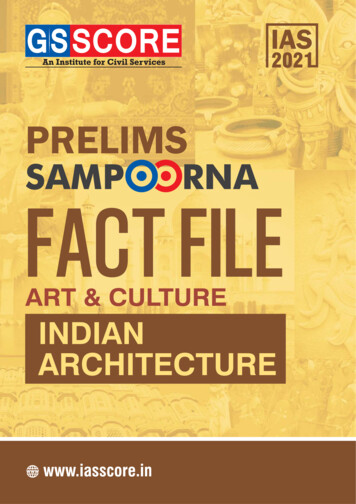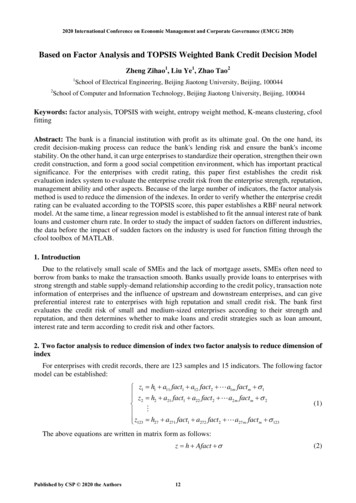
Transcription
PRELIMS SAMPOORNAAs IAS prelims 2021 is knocking at the door, jitters and anxiety is a common emotion that anaspirant feels. But if we analyze the whole journey, these last few days act most crucial in yourpreparation. This is the time when one should muster all their strength and give the final punchrequired to clear this exam. But the main task here is to consolidate the various resources that anaspirant is referring to.GS SCORE brings to you, Prelims Sampoorna, a series of all value-added resources in your prelimspreparation, which will be your one-stop solution and will help in reducing your anxiety and boostyour confidence. As the name suggests, Prelims Sampoorna is a holistic program, which has 360degree coverage of high-relevance topics.It is an outcome-driven initiative that not only gives you downloads of all resources which youneed to summarize your preparation but also provides you with All India open prelims mocktests series in order to assess your learning. Let us summarize this initiative, which will include: GS Score UPSC Prelims 2021 Yearly Current Affairs Compilation of All 9 Subjects Topic-wise Prelims Fact Files (Approx. 40) Geography Through Maps (6 Themes) Map Based Questions ALL India Open Prelims Mock Tests Series including 10 Tests Compilation of Previous Year Questions with Detailed ExplanationWe will be uploading all the resources on a regular basis till your prelims exam. To get the maximumbenefit of the initiative keep visiting the website.To receive all updates through notification, subscribe:
www.iasscore.inIAS 2021 ART & CULTURE (INDIAN ARCHITECTURE) 1INDIANARCHITECTUREClassification of Architecture in India1. Indus Valley Civilization2. Mauryan Architecture3. Post Mauryan Architecture4. Gupta Architecture5. Temple Architecture6. Indo-Islamic Architecture7. European Architecture1. Indus Valley Civilization The Indus Valley Civilization covered a large area around the Indus River basin and beyond in lateBronze Age India. In its mature phase, from about 2600 to 1900 BCE, it produced several citiesmarked by great uniformity within and between sites, including Harappa, Lothal, and the UNESCOWorld Heritage Site Mohenjo-Daro. The Harappan culture was distinguished by its system of townplanning. The use of burnt bricks in the Harappan cities is remarkable, because in the contemporary buildingsof Egypt mainly dried bricks were use.
2IAS 2021 PRELIMS SAMPOORNA Grid Pattern: Harappa and Mohen-Jo Dero werelaid out on a grid pattern and had provisions for anadvanced drainage system. Streets were orientedeast to west. Each street was having a well organizeddrainage system. City Walls: Each city in the Indus Valley was surroundedby massive walls and gateways. The walls were builtto control trade and also to stop the city from beingflooded. The Residential Buildings: The residential buildings,which were serviceable enough, were mainly made upof brick and consisted of on open terrace flanked byrooms. These houses were made of standardized bakedbricks (which had a ratio of length to width to thicknessat 4:2:1) as well as sun dried bricks. Some houses evenhad multiple stories and paved floors. In-house wells: Almost every house had its own wells,drains and bathrooms. The in-house well is a commonand recognizable feature of the Indus Valley Civilization.Kalibangan many houses had their wells. Drainage System: The drainage system of MohenjoDaro was very impressive. Each house was connecteddirectly to an excellent drainage system, which indicatesa highly developed municipal life. Granaries: The largest building found at Mohenjo-Darois a granary, running 150 feet long, 75 feet wide and 15feet high. It was well ventilated and it was possible tofill grain in from outside. The large size of the granaryprobably indicates a highly developed agriculturalcivilization. Great Bath: The Great bath at Mohenjo-Daro is about179 feet long and 107 feet wide. The complex has alarge quadrangle in the center with galleries and roomson all sides. In the center of this quadrangle there is alarge swimming enclosure that is 39 feet long, 23 feetwide and 8 feet deep. The entire complex is connectedto an elaborate water supply and sewer system. TheGreat Bath was probably used for religious or ritualisticpurposes.www.iasscore.in
www.iasscore.inIAS 2021 ART & CULTURE (INDIAN ARCHITECTURE) 2. Mauryan Architecture After the Indus Valley Civilization, there are few traces ofIndian architecture, which probably mostly used wood, orbrick which has been recycled, until around the time ofthe Maurya Empire, from 322 to 185 BCE. From this periodfor several centuries onwards, much the best remains areof Indian rock-cut architecture, mostly Buddhist, and thereare also a number of Buddhist images that give very usefulinformation. Ashoka embraced Buddhism and the immense Buddhistmissionary activities that followed encouraged thedevelopment of distinct sculptural and architectural styles.This can be classified into Stupas, Pillars, Caves, andPalaces. Stupa: In the Mauryan period, mainly in the period of Ashokanumerous stupas were constructed and scattered all overthe country. The stupas of solid domes were constructed ofbrick or stone with different sizes. The Ashoka stupas wereconstructed to celebrate the achievements of GautamaBuddha. Pillars: The most famous and mind boggling monumentsof Mauryan art were the Pillars, the pillars of Dharma. ThesePillars were not used for support and stand free in columns.Two main parts of the pillars were the shaft and the capital. Amonolith column made of one piece of stone with exquisitepolish is a shaft. Polishing art of the pillar is very uniqueand seems to be like a metal. Usually animal figures are thecapital figures and carved standing on a square or circularabacus. Abacuses are decorated with stylized lotuses. Lion capital: Capital of Mauryan period found at Sarnathnear Varanasi, known as the Lion Capital. Being one of thefinest examples of Mauryan sculpture and built by Ashokain commemoration of Dhamma chakra pravartanan or firstsermon of Buddha. The capital has four Asiatic lions seatedback to back, which symbolize power, courage, pride andconfidence. The sculpture surface was polished and the drumwas there on the bell base, i.e. Abacus has the depiction ofchakra or wheel on all four directions and a bull, horse, anelephant and a lion between every chakra. It has 24 spokesand these 24 spoke chakra is adopted to the National Flagof India. Cave: Instead of pillars, rock cut caves are also an artisticachievement of Ashoka’s reign. The caves at Barabar hill inthe north of Gaya and the Nagarjuni hill caves, the Sudamacaves, etc. are the several examples of cave architecture. Thehills of Barabar caves were donated by Ashoka to Ajivikamonks and three separate caves at Nagarjuni hills were byDasharatha to them. The cave of Gopika was excavated inthe reign of Dasratha in a tunnel like fashion. The interiorpart of the cave is polished like a mirror.3
4IAS 2021 PRELIMS SAMPOORNA www.iasscore.in Palaces: The palace of Mauryan period had gilded pillars with golden vines and silver birds. Allthe towns were surrounded by the high walls with battlements, water ditches, bearing lotuses andplants3. Post Mauryan Architecture With the decline of the Mauryan Empire several small dynasties rose to power. Among them, Shungas,Kanvas, Kushanas and Shakas in the north and Satvahanas, Ikshavakus, Abhiras, and Vakatakas inSouthern and Western India gained prominence. The architecture in the form of rock-cut caves and stupas continued, with each dynasty introducingsome unique features of their own. Similarly, different schools of sculpture emerged and the art of sculpture reached its climax in thepost-Mauryan period. The construction of rock caves continued as in the Mauryan period. However, this period saw thedevelopment of two types of rock caves – Chaitya and Viharas. Chaitya was a rectangular prayer hallwith a stupa placed in the center, for the purpose of prayer and Viharas were used as the residencesof the monks. Post Mauryan period stupas became larger and more decorative and wood and brickwork werereplaced by stone. Post Mauryan empire three prominent schools of the sculpture came into prominence in threedifferent regions of India namely Gandhara, Mathura, and Amravati schools.4. Gupta Architecture Most prominent architectural marvels of Gupta period are temples. Most of the temples built in theGupta era were carved with representation of Gods (mainly avatara of Vishnu and Lingams) andGoddesses. The Shikhara was not much prominent in the early Gupta temples but was prominent inlater Gupta era. There was a single entrance or mandapa or Porch.
www.iasscore.inIAS 2021 ART & CULTURE (INDIAN ARCHITECTURE) 5 Gupta style temple was modelled on the architectural norms of the Mathura school. Sanchi templeat Tigwa has a flat roof. Dasavatar Temple at Deogarh, Bhitargaon temple and Mahadev Temple atNachna Kuthar have a square tower of Shikhara. Manyar Math at Rajgriha is a circular temple ofGupta Era. Main style of temple architecture in Gupta period is Nagara style. The most famous remaining monuments in a broadly Gupta style, the caves at Ajanta, Elephanta, andEllora (respectively Buddhist, Hindu, and mixed including Jain) were in fact produced under otherdynasties in Central India, and in the case of Ellora after the Gupta period, but primarily reflect themonumentality and balance of Guptan style. The Ajanta Caves constitute ancient monasteries and worship-halls of different Buddhist traditionscarved into a 75-metre (246 ft) wall of rock. The caves also present paintings depicting the past livesand rebirths of the Buddha, pictorial tales from Aryasura’s Jatakamala, and rock-cut sculptures ofBuddhist deities. Ellora is a UNESCO World Heritage Site located in the Aurangabad district of Maharashtra. It is one ofthe largest rock-cut monastery-temple cave complexes in the world, featuring Hindu, Buddhist andJain monuments, and artwork, dating from the 600–1000 CE period. Cave 16, in particular, featuresthe largest single monolithic rock excavation in the world, the Kailasha temple, a chariot shapedmonument dedicated to Lord Shiva. The Hindu Udayagiri Caves actually record connections with the dynasty and its ministers, and theDashavatara Temple at Deogarh is a major temple, one of the earliest to survive, with importantsculpture.5. Temple ArchitectureClassification of Indian Templesf Nagara (in North India) is associated with the land between the Himalayas and Vindhyas.f Dravida (in South India) with the land between the Krishna and Kaveri rivers.f Vesara stylef Hoysala stylef Vijayanagara Artf Nayaka stylef Pala Schoolf Jain Architecture Nagara StyleFrom fifth century AD onwards, a distinct style of temple architecture developed in the northern partof India, known as Nagara style of architecture. Within nagara style different sub-schools emerged inwestern, central and eastern parts of the country." Garbhagrihay Literally means ‘womb-house’ and is a cave like sanctumy Garbhagriha is made to house the main icon (main deity)
6IAS 2021 PRELIMS SAMPOORNA www.iasscore.in" Mandapay It is the entrance to the templey May be a portico or colonnaded (series of columns placed at regular intervals) hall thatincorporate space for a large number of worshipersy Some temples have multiple mandapas in different sizes named as Ardhamandapa, Mandapaand Mahamandapa" Shikhara or Vimana" They are mountain like spire of a free standing templey Shikhara is found in North Indian temples and Vimana is found in South Indian templesy Shikhara has a curving shape while vimana has a pyramidal like structure" Amalakay A stone disc like structure at the top of the temple shikara" Kalashay Topmost point of the temple above Amalaka" Antarala (vestibule)y A transition area between the Garbhagriha and the temple’s main hall (mandapa)" Jagatiy A raised platform for sitting and praying" Vahanay Vehicle of the temple’s main deity along with a standard pillar or Dhvaj
www.iasscore.inIAS 2021 ART & CULTURE (INDIAN ARCHITECTURE) 7Three sub schools developed under Nagara style: Odisha School" Most of the main temple sites are located in ancient Puri and Konark." Here the shikhara, called deul in Odisha, is vertical almost until the top when it suddenly curvessharply inwards." Deuls are preceded, as usual, by mandapas called jagamohana in Odisha." The ground plan of the main temple is square, which, in the upper reaches of its superstructurebecomes circular in the crowning mastaka." The exterior of the temples are lavishly carved, their interiors generally quite bare." Odisha temples usually have boundary walls." Example: Konark Temple, Jagannath temple, Lingaraj temple. Khujuraho/Chandel school" Khajuraho’s temples are known for their extensive erotic sculptures" Patronized by Chandela kings of Bundelkhand (10th and 11th century)." These 22 temples (out of the original 85) are regarded as one of world’s greatest artisticwonders." The finest among them is Shaivite temple known as Kandariya Mahadev, built around 10th centuryby King Ganda" The standard type of Khajuraho temple has a shrine room, an assembly hall, and an entranceportico." These entities were treated as a whole, whereas in the Odishan style they were conceived asseparate elements." The sikhara is curved for its whole length, and miniature sikharas emerge from the central tower." The halls and porticos of the temple are also crowned with smaller towers which rise progressivelyupto the main tower." Vishnu Temple at Chaturbhunj (MP) is another prominent temple at Khajuraho. Solanki School" Patronized by Solanki kings (later Chalukya) of Gujarat (11th to 13th century)." The Vimala, Tejpala and Vastupala temples at Mount Abu exhibit this style." Dilwara temple in Mt Abu – Highest Jain pilgrimage Dravida Temple Style" Unlike the nagara temple, the dravida temple is enclosed within a compound wall." The front wall has an entrance gateway in its centre, which is known as Gopura/ Gopuram." The shape of the main temple tower is known as Vimana (shikhara in nagara style)." The vimana is like a stepped pyramid that rise up geometrically rather than the curving shikharaof north India." In south India, the word Shikhara is used only for the crowning element at the top of the templewhich is usually shaped like a small stupika or an octagonal cupola (this is equivalent to theamalaka or kalasha of north Indian temples).
8IAS 2021 PRELIMS SAMPOORNA www.iasscore.in Vesara Temple Style" The Vesara is one of a number of terms for a distinct stylistic tradition of Indian Hindu templearchitecture primarily used in the Deccan, parts of North India and Central India, between theVindhyas and the river Krishna. According to some, the style was started by the Chalukyas ofBadami (500-753AD)." Vesara style contains elements of both Dravida and Nagara styles. In particular the shape of thesuperstructure over the sanctum is usually pyramidal in profile, and shorter than the northernshikhara tower. In plan the walls and superstructure are broadly circular, or a straight-sided cone,though its geometry is based on rotating a square imposed on a circle. It has rather differentdecoration and motifs to either." One common motif is in fact miniature shikharas, often of the bhumija type, showing that thearchitects were well aware of northern styles. Like the southern vimana superstructure, the Vesaraequivalent is strongly divided into storeys or steps, but there are more of them, and the kapotaroof motif that is so common in contemporary southern vimanas is less dominant. Hoysala Temple Architecture" Hoysala architecture is the building style in Hindu temple architecture developed under the rule ofthe Hoysala Empire between the 11th and 14th centuries, in the region known today as Karnataka,a state of India.
www.iasscore.inIAS 2021 ART & CULTURE (INDIAN ARCHITECTURE) 9" The Hoysala era (1026 CE – 1343 CE) was marked by illustrious achievements in art, architecture,and culture. The nucleus of this activity lay in the present day Hassan district of Karnataka, India." The Hoysalas usually dedicated their temples to Shiva or to Vishnu (two of the popular Hindugods), but they occasionally built some temples dedicated to the Jain faith as well." Most of these temples have secular features with broad themes depicted in their sculptures.This can be seen in the famous Chennakesava Temple at Belur dedicated to Vishnu and in theHoysaleswara temple at Halebidu dedicated to Shiva. Vijaynagar Temple Style" The Vijayanagar Empire ruled in South India from 1336 until 1646 and left a lasting legacy ofarchitecture, sculpture, and painting." Vijayanagar architecture is a vibrant combination of the Chalukya, Hoysala, Pandya, and Cholastyles, which evolved from prior empires in earlier centuries. It is also influenced by later Deccanand Dravidian styles.
10IAS 2021 PRELIMS SAMPOORNA www.iasscore.in" Preferred for its durability, local hard granite was the building material of choice, as it had beenfor the Badami Chalukyas." Vijayanagar temples are characterized by ornate pillared halls and rayagopurams, or monumentaltowers adorned with life-sized figures of gods and goddesses that stand at the entrance of thetemple." The courtly architecture of Vijayanagar is generally made of mortar mixed with stone rubble andoften shows secular styles with Islamic-influenced arches, domes, and vaults. Vayaka Temple Style" The Nayak reign in South India was renowned forits unique style of temple architecture." The Nayak dynasties emerged in South India afterthe downfall of the Vijayanagar Empire in 1565,when the Nayak military governors declaredindependence; they then ruled from the 16th to18th century." Nayak rule was noted for its administrativereforms, its artistic and cultural achievements,and the creation of a unique style of templearchitecture." Nayak architectural style was characterizedbyelaboratehundredandthousandpillared mandapas (outdoor temple halls), thehigh gopurams (towers) with painted stuccostatues on the surface, and long corridors." Nayak civic architecture combines Dravidian and Islamic styles, as exemplified by the palaceerected by King Thirumalai Nayak of the Madurai Nayak dynasty in 1636 CE. Pala Style" The temples are known to express the local vanga style developed in the period between 8thand 12th century AD under patronage of Pala and Sena dynasty. The ninth century SiddheshvaraMahadeva temple in Baraker shows a tall curving shikara crowned by a large amalaka and is anexample of the early Pala style." The rock cave temple at Kahalgaon (9th century) shows the gabled vault roof characteristic of theSouth Indian architecture. Jain Architecture" Jain temple architecture is generally close to Hindu temple architecture, and in ancient timesBuddhist religious architecture. The basic layout of a Hindu and most Jain temples has consistedof a small garbhagriha or sanctuary for the main murti or cult images, over which the highsuperstructure rises, then one or larger mandapa halls." Very often numbers of rock-cut Jain temples and monasteries share a site with those of the otherreligions, as at Udayagiri, Bava Pyara, Ellora, Aihole, Badami, and Kalugumalai. The Ellora Cavesare a late site, which contains temples of all three religions, as the earlier Buddhist ones give wayto later Hindu excavations." There is considerable similarity between the styles of the different religions, but often the Jainsplaced large figures of one or more of the 24 tirthankaras in the open air rather than inside the
www.iasscore.inIAS 2021 ART & CULTURE (INDIAN ARCHITECTURE) 11shrine." These statues later began to be very large, normally standing nude figures in the kayotsargameditation position (which is similar to standing at attention). Examples include the Gopachal rockcut Jain monuments and the Siddhachal Caves, with groups of statues, and a number of singlefigures including the 12th-century Gommateshwara statue, and the modern Statue of Vasupujyaand, largest of all at 108 feet (32.9 meters) tall, the Statue of Ahimsa." Regional differences in Hindu temples are largely reflected in Jain ones, except that Māru-Gurjaraarchitecture or the “Solanki style” has become to some extent a pan-Indian, indeed pan-globalJain style. This is a particular temple style from Gujarat and Rajasthan that originated in bothHindu and Jain temples." It has remained in use, in somewhat modified form, to the present day, indeed also becomingpopular again for some Hindu temples in the last century. The style is seen in the groups ofpilgrimage temples at Dilwara on Mount Abu, Taranga, Girnar and Palitana.6. Indo-Islamic Architecture During Sulatanate Period" The architecture of the period of the Sultanate can be divided into three categories. First is theDelhi or the Imperial style of architecture which grew under the patronage of Sultans of Delhi. Itincludes all those buildings which were constructed by different Sultans. The other is provincialstyle of architecture which grew under the patronage of provincial ruling dynasties which weremostly Muslims." The Imperial style, of course, influenced the style of provincial architecture, yet the provincial artshad their own different characteristics which assigned them different places." The third- Hindu architecture which mostly developed under Hindu kings of Rajasthan and theVijayanagara Empire." Hindu architecture was also influenced by the Imperial style. The Hindus had already a welldeveloped style of their own prior to the coming of the Muslims in India. Therefore, features oftheir past style continued to be the governing factors of their style of architecture." The Turks were influenced by that Iranian style of architecture and when they settled down in Indiathey maintained its characteristics which were borrowed from the Indians to a certain extent.
12IAS 2021 PRELIMS SAMPOORNA www.iasscore.in" The Muslim rulers in provinces also built up palaces, tombs, forts, mosques, etc. in their respectivekingdoms. Primarily, the provincial styles drew inspiration from the Delhi style of architecture." The earliest examples of Indo-Islamic architecture were constructed during this period by theDelhi Sultanates, most famously the Qutb Minar complex, which was designated a UNESCO WorldHeritage Site in 1993." Qutb-ud-din Aibak constructed the Qutb-ul-Islam mosque at Delhi and another mosque at Ajmercalled the Dhai Din Ka Jhonpra." The construction of Qutb Minar was originally planned by Aibak but it was completed byIltutmish." Alai Minar, a minaret twice the size of Qutb Minar was commissioned by Alauddin Khilji but nevercompleted. Other examples include the Tughlaqabad Fort and Hauz Khas Complex. Mughal Architecture" Mughal architecture is the type of Indo-Persian architecture developed by the Mughals in the16th, 17th and 18th centuries throughout the ever-changing extent of their empire in the Indiansubcontinent." It developed the styles of earlier Muslim dynasties in India as an amalgam of Islamic, Persian,Turkish and Indian architecture. Mughal buildings have a uniform pattern of structure andcharacter, including large bulbous domes, slender minarets at the corners, massive halls, largevaulted gateways, and delicate ornamentation; “grandiose architecture was the most visible of theways that the Mughals used to assert their sense of superiority and their supremacy over what inmany ways remained to them an alien land”.Examples of the style can be found in modern-dayIndia, Afghanistan, Bangladesh, and Pakistan." Mughal Inlay art is a remarkable feature of Mughal architecture in India and Inlay art was aninstrument of dynamic expression in the great age of the Mughal Empire. The Monuments ofAgra (India) provide the different stages of the development of Mughal Inlay art in a progressivesequence during sixteenth to seventeenth century as practiced under Akbar (r. 1556-1605),Jahangir (r. 1605-1627), and Shah Jahan (r. 1628-1658)." Marble inlay-‘Pachchikari’ or ‘Parchinkari’ is one of the most beautiful and popular forms of Mughalart developed indigenously in India." Inlay technically known as Pietra dura is marble inlaid with designs in precious or semi-preciousstonework." Mughal gardens are gardens builtby the Mughals in the Islamic style.This style was influenced by Persiangardens. They are built in the charbagh structure, which a quadrilateralgarden layout is based on the fourgardens of Paradise mentioned in theQur’an. This style is intended to createa representation of an earthly utopiain which humans co-exist in perfectharmony with all elements of nature." The quadrilateral garden is dividedby walkways or flowing water intofour smaller parts. Significant use ofrectilinear layouts is made within the walled enclosures. Some of the typical features include pools,fountains and canals inside the gardens.
www.iasscore.inIAS 2021 ART & CULTURE (INDIAN ARCHITECTURE) 13" Mughal architecture has also influenced later Indian architectural styles, including the IndoSaracenic style of the British Raj, the Rajput style and the Sikh style." Babur: Babur was not impressed by Indian architecture. At the same time he was busy in wagingwars. During his five-year reign, Babur took considerable interest in erecting buildings, though fewhave survived. He constructed several buildings but only two mosques—one at Panipat and theother at Sambhal have survived." Akbar: Agra fort is a UNESCO world heritage site in Agra, Uttar Pradesh. The major part of Agrafort was built by Akbar from 1565 to 1574. The architecture of the fort clearly indicates the freeadoption of the Rajput planning and construction. Buland Darwaza is the highest gateway inthe world and is an example of Mughal architecture. It displays sophistication and heights oftechnology in Akbar’s empire." Jahangir: The Begum Shahi Mosque is an early 17th-century mosque situated in the Walled Cityof Lahore, Pakistan. The mosque was built between 1611 and 1614 during the reign of MughalEmperor Jahangir." Shahjahan: Mughal architecture reached its zenith during the reign of Shah Jahan, who constructedthe Jama Masjid, Moti Masjid at Agra fort, Shalimar Gardens of Lahore, the Wazir Khan Mosque,and who renovated the Lahore Fort. The Taj Mahal, a World Heritage Site was built between1630–49 by the emperor Shah Jahan in memory of his wife Mumtaz Mahal. It is a large, whitemarble structure standing on a square plinth and consists of a symmetrical building with an iwan(an arch-shaped doorway) topped by a large dome and finial" Aurangzeb: The Badshahi Mosque in Lahore, Pakistan was commissioned by the sixth MughalEmperor Aurangzeb. Constructed between 1671 and 1673, it was the largest mosque in the worldupon construction. The Bibi Ka Maqbara is a tomb located in Aurangabad, Maharashtra, India. Itwas commissioned in 1660 by the Mughal emperor Aurangzeb in the memory of his first and chiefwife Dilras Banu Begum and is considered to be a symbol of Aurangzeb’s ‘conjugal fidelity’7. European ArchitectureThe European architecture can be divided into following types: Neo-classical Style" This architectural style is reflected in the late 19th century structures in British India." It is an imitation of the classical Greeko-Roman style of architecture." It involved recreation, revival, re-adaptation of building architecture in ancient Greece and Rome." The Mediterranean origins of this architecture were thought to be suitable for Indian tropicalclimate." It was characterised by the construction of geometrical structures fronted with lofty pillars." An early example of this style is Town Hall in Bombay. Neo-Gothic Style" The neo-Gothic style was a revival of the early Gothic style of architecture which had its roots inbuildings, especially churches, built in northern Europe during the medieval period." It was characterised by high-pitched roofs, pointed arches and detailed decoration." This style was adapted for building infrastructure in Bombay." An impressive group of buildings facing the seafront including the Secretariat, University ofBombay and High Court were all built in this style.
14IAS 2021 PRELIMS SAMPOORNA www.iasscore.in" Many Indians merchants gave money for some of these buildings. They were happy to adopt theneo-Gothic style since they believed it was progressive and would help make Bombay, a moderncity." The British invested a lot in the design and construction of railway stations in this style, an exampleof which is Chhatrapati Shivaji Terminus in Mumbai. Indo-Saracenic Style" It was a hybrid of Indian and European style which developed in an early twentieth century." Indo was shorthand for Hindu and Saracen was a term Europeans used to designate Muslim." The Indo-Saracenic revival architecture drew elements from native Indo-Islamic architecture andcombined it with Neo-Classical styles favoured in Victorian Britain." The inspiration for this style was medieval buildings in India with their domes, chhatris, jalis, andarches etc." Chepauk Palace situated in Chennai (erstwhile Madras) was the first Indo-Saracenic revivalbuilding." The Gateway of India is the most famous example of this style. The industrialist Jamsetji Tata builtthe Taj Mahal Hotel in the similar style. Art-Deco Style" Art Deco in India (and especially in Mumbai) evolved into a unique style that came to be calledDeco-Saracenic." Essentially, it was a combination of the Islamic and the Hindu architectural styles." Art Deco is one of Mumbai s least noticed architectural styles, though Mumbai and its suburbspossibly have the largest number of Art Deco buildings in the world." Deco details touch every architectural aspect flooring, wood panelling, railings, weather shades,verandahs, balconies and facades that are very airy and b
chakra or wheel on all four directions and a bull, horse, an elephant and a lion between every chakra. It has 24 spokes and these 24 spoke chakra is adopted to the National Flag of India. Cave: Instead of pillars, rock cut caves are also an artistic achievement of Ashoka's reign. The caves at Barabar hill in











